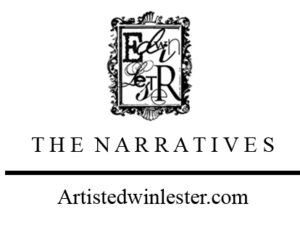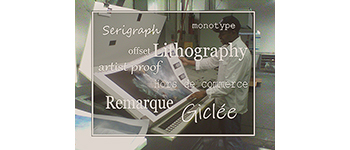A few Definitions.
Iris or Giclée – A computerized reproduction technique in which the image and topography are generated from a digital file and printed by a special ink jet printer, using ink, acA monoscenic narrative..rylic or oil paints. Giclée printing offers one of the highest degree of accuracy and richness of color available in any reproduction techniques.
Lithography – Printing technique using a planographic process in which prints are pulled on a special press from a flat stone or metal surface that has been chemically sensitized so that ink sticks only to the design areas and is repelled by the non-image areas. Lithography was invented in 1798 in Germany by Alois Senefelder.
Mezzotint – A reverse engraving process used on a copper or steel plate to produce illustrations in relief with effects of light and shadow. The surface of a master plate is roughened with a tool called a rocker so that if inked, it will print solid black. The areas to be white or gray in the print are rubbed down so as not to take ink. It was widely used in the 18th and 19th centuries to reproduce portraits and other paintings, but became obsolete with the introduction of photo-engraving.
Monotype – One-of-a-kind print made by painting on a sheet of metal or glass and transferring the still-wet painting onto a sheet of paper by hand or with an etching press. If enough paint remains on the master plate, additional prints can be made, however, the reprint will have substantial variations from the original image. Monotype printing is not a multiple-replica process since each print is unique.
Offset Lithography – A special photo-mechanical technique in which the image to be printed is transferred to the negative plates and printed onto paper. Offset lithography is very well adapted to color printing.
Serigraphy (Silk-screen) – A printing technique that makes use of a squeegee to force ink directly onto a piece of paper or canvas through a stencil creating an image on a screen of silk or other fine fabric with an impermeable substance. Serigraphy differs from most other printing in that its color areas are paint films rather than printing ink stains.
Common Art Print Terms
Acid-free Paper or Canvas – Paper or canvas treated to neutralize its natural acidity in order to protect fine art and photographic prints from discoloration and deterioration.
Canvas Transfer – Art reproduction on canvas which is created by a process such as serigraphy, photomechanical or giclée printing. Some processes can even recreate the texture, brush strokes and aged appearance of the original work.
Color-variant Suite – A set of identical prints in different color schemes.
Impression – Fine art made by any printing stamping process.
Limited Edition – A limited number of identical prints numbered in succession and signed and supervised by the artist. Any additional prints have been destroyed.
Monoprint – One-of-a-kind print conceived and printed by the artist and or under the artist’s supervision.
Montage (Collage) – An artwork comprising of portions of various existing images such as from photographs or prints and arranged so that they join, overlap or blend to create a new image.
Multiple Originals – A set of identical fine prints in which the artist personally conceived the image, created the master plates and executed or supervised the entire printing process. Example: etching.
Multiple Reproductions – A set of identical fine prints reproducing the image of an original artwork created by a non-printing process. Example: serigraph of an oil on canvas.
Open Edition – A series of prints or objects in an art edition that has an unlimited number of copies.
Original Print – One-of-a-kind print in which the artist personally conceived the image, created the master plates and executed the entire printing process.
Provenance – Record of ownership for a work of art, ideally from the time it left the artist’s studio to its present location, thus creating an unbroken ownership history.
Remarque – Additional enhancements by the artist on some or all of the final prints within an edition.
Restrike – Additional prints made from a master plate, block, lithograph stone, etc. after the original edition has been exhausted.
Print Proof Types
Proofs are prints authorized by the artist in addition to the limited signed and numbered edition. The total size of an art edition consists of the signed and numbered prints plus all outstanding proofs. If a set of proofs consists of more than one print, numbers are inscribed to indicate the number of the prints within the total number of the particular type of proof, (e.g., AP 5/20 means the fifth print in a set of twenty identical prints authorized as artist proofs). Proofs are generally signed by the artist as validation of the prints.
Artist’s Proof (AP) – Print intended for the artist’s personal use. It is common practice to reserve approximately ten percent of an edition as artist’s proofs, although this figure can be higher. The artist’s proof is sometimes referred to by its French épreuve d’artist (abbreviation E.A.). Artist’s proofs can be distinguished by the abbreviation AP or E.A., commonly on the lower left of the work.
Cancellation Proof – Final print made once an edition series has been finished to show that the plate has been marred/mutilated by the artist, and will never be used again to make more prints of the edition.
Hors d’Commerce Proof (HC) – Print identical to the edition print intended to be used as samples to show to dealers and galleries. These proofs may or may not be signed by the artist.
Printer’s Proof (PP) – Print retained by the printer as a reference. Artists often sign these prints as a gesture of appreciation.
Trial Proof (TP) – Pre-cursor to a limited edition series, these initial prints are pulled so that the artist may examine, refine and perfect the prints to the desired final state. Trial proofs are generally not signed.
Abbreviations Used in Art
2nd Ed – Second edition: prints of the same image as the original edition but altered in some way (as in change of color, paper or printing process).
2nd st – Second state: prints of proofs which contain significant changes from the original print.
AP – Artist’s Proof (see definition)
Del – (Latin, delineavit) He (she) drew it. Generally inscribed next to the artist’s signature.
HC – (French, Hors d’Commerce) Prints from an edition intended to be used as samples to show to dealers and galleries.
PP – Printer’s proof (see definition)
TP – Trial proof (see definition)




